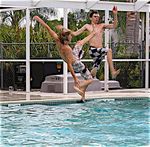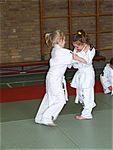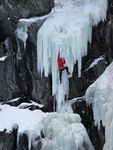Framing Image Description as a Ranking Task: Data, Models and Evaluation Metrics
←
→
Page content transcription
If your browser does not render page correctly, please read the page content below
Journal of Artificial Intelligence Research 47 (2013) 853-899 Submitted 03/13; published 08/13
Framing Image Description as a Ranking Task:
Data, Models and Evaluation Metrics
Micah Hodosh mhodosh2@illinois.edu
Peter Young pyoung2@illinois.edu
Julia Hockenmaier juliahmr@illinois.edu
Department of Computer Science
University of Illinois
Urbana, IL 61801, USA
Abstract
The ability to associate images with natural language sentences that describe what
is depicted in them is a hallmark of image understanding, and a prerequisite for appli-
cations such as sentence-based image search. In analogy to image search, we propose to
frame sentence-based image annotation as the task of ranking a given pool of captions.
We introduce a new benchmark collection for sentence-based image description and search,
consisting of 8,000 images that are each paired with five different captions which provide
clear descriptions of the salient entities and events. We introduce a number of systems
that perform quite well on this task, even though they are only based on features that
can be obtained with minimal supervision. Our results clearly indicate the importance of
training on multiple captions per image, and of capturing syntactic (word order-based) and
semantic features of these captions. We also perform an in-depth comparison of human
and automatic evaluation metrics for this task, and propose strategies for collecting human
judgments cheaply and on a very large scale, allowing us to augment our collection with
additional relevance judgments of which captions describe which image. Our analysis shows
that metrics that consider the ranked list of results for each query image or sentence are
significantly more robust than metrics that are based on a single response per query. More-
over, our study suggests that the evaluation of ranking-based image description systems
may be fully automated.
1. Introduction
The ability to automatically describe the entities, events and scenes depicted in an image
is possibly the most ambitious test of image understanding. Any advances on this task
have significant practical implications, since there are billions of images on the web and in
personal photo collections. Our ability to efficiently access the wealth of information they
contain is hampered by limitations of standard image search engines, which must rely on
text that appears near the image (Datta, Joshi, Li, & Wang, 2008; Popescu, Tsikrika, &
Kludas, 2010). There has been a lot of work on the multi-label classification problem of
associating images with individual words or tags (see, e.g., Blei & Jordan, 2003; Barnard,
Duygulu, Forsyth, Freitas, Blei, & Jordan, 2003; Feng & Lapata, 2008; Deschacht & Moens,
2007; Lavrenko, Manmatha, & Jeon, 2004; Makadia, Pavlovic, & Kumar, 2010; Weston,
Bengio, & Usunier, 2010), but the much harder problem of automatically associating images
with complete sentences that describe them has only recently begun to attract attention.
©2013 AI Access Foundation. All rights reserved.Hodosh, Young & Hockenmaier
1.1 Related Work
Although a few approaches have framed sentence-based image description as the task of map-
ping images to sentences written by people (Farhadi, Hejrati, Sadeghi, Young, Rashtchian,
Hockenmaier, & Forsyth, 2010; Ordonez, Kulkarni, & Berg, 2011), most research in this
area has focused on the task of automatically generating novel captions (Kulkarni, Premraj,
Dhar, Li, Choi, Berg, & Berg, 2011; Yang, Teo, Daume III, & Aloimonos, 2011; Li, Kulka-
rni, Berg, Berg, & Choi, 2011; Mitchell, Dodge, Goyal, Yamaguchi, Stratos, Han, Mensch,
Berg, Berg, & Daume III, 2012; Kuznetsova, Ordonez, Berg, Berg, & Choi, 2012; Gupta,
Verma, & Jawahar, 2012). We argue in this paper that framing image description as a nat-
ural language generation problem introduces a number of linguistic difficulties that detract
attention from the underlying image understanding problem we wish to address. Since any
sentence-based image description or retrieval system requires the ability to associate images
with captions that describe what is depicted in them, we argue it is important to evaluate
this mapping between images and sentences independently of the generation aspect. Re-
search on caption generation has also ignored the image search task, which is arguably of
much greater practical importance.
All of the systems cited above are either evaluated on a data set that our group released
in earlier work (Rashtchian, Young, Hodosh, & Hockenmaier, 2010), or on the SBU Cap-
tioned Photo Dataset (Ordonez et al., 2011). Our data set consists of 1,000 images from the
PASCAL VOC-2008 object recognition challenge that are each annotated with five descrip-
tive captions which we purposely collected for this task. The SBU data set consists of one
million images and captions harvested from Flickr. Gupta et al. (2012) is the only system to
use Grubinger, Clough, Müller, and Deselaers’s (2006) IAPR TC-12 data set, which consists
of 20,000 images paired with longer descriptions.
Although details differ, most models rely on existing detectors to define and map images
to an explicit meaning representation language consisting of a fixed number of scenes, objects
(or ‘stuff’), their attributes and spatial relations (Farhadi et al., 2010; Kulkarni et al., 2011;
Li et al., 2011; Yang et al., 2011; Ordonez et al., 2011; Mitchell et al., 2012). But it is
unclear how well these detector-based approaches generalize: the models evaluated on our
PASCAL VOC-2008 data set (Farhadi et al., 2010; Kulkarni et al., 2011; Li et al., 2011;
Yang et al., 2011; Mitchell et al., 2012) all rely on detectors that may have been trained on
images contained in this corpus, and Kuznetsova et al. (2012) select a test set of 1,000 images
from the SBU data set for which their detectors work well. Moreover, among the systems
evaluated on our PASCAL VOC-2008 data set, only Kulkarni et al. (2011), Li et al. (2011),
Li et al. (2011) and Mitchell et al.’s (2012) results may be directly comparable, since different
research groups report different evaluation metrics and use a different parts of the data set
as test or training data. The evaluation of generation systems is generally well known to be
difficult (see, e.g., Dale & White, 2007; Reiter & Belz, 2009), and typically requires expensive
human judgments that have to consider the quality of both content selection (what is being
described) and surface realization (the fluency of the generated text). These syntactic and
pragmatic issues confound the purely semantic question of whether the image is correctly
described by the caption.
854Framing Image Description as a Ranking Task
1.2 Our Approach
In this paper, we focus on the task of associating images with sentences drawn from a large,
predefined pool of image descriptions. These descriptions are not generated automatically
or harvested from the web (Feng & Lapata, 2008; Ordonez et al., 2011), but are written
by people who were asked to describe them. We argue that evaluating the ability to select
or rank, rather than generate, appropriate captions for an image is the most direct test
of the fundamental semantic question of how well we can associate images with sentences
that describe them well. Framing image description as a ranking task also has a number
of additional advantages. First, it allows us to handle sentence-based image annotation
and search in a unified framework, allowing us to evaluate whether advances in one task
carry over to the other. Second, framing image description as a ranking problem greatly
simplifies evaluation. By establishing a parallel between description and retrieval, we can
use the same metrics to evaluate both tasks. Moreover, we show that the rank of the
original caption, which is easily determined automatically, leads to metrics that correlate
highly with systems rankings obtained from human judgments, even if they underestimate
actual performance. We also show that standard automatic metrics such as Bleu (Papineni,
Roukos, Ward, & Zhu, 2002) or Rouge (Lin, 2004) that have also been used to evaluate
caption generation systems show poor correlation with human judgments, leading us to
believe that the evaluation of caption generation system should not be automated. We also
perform a large-scale human evaluation, but since the sentences in our data set are image
descriptions written by people, we only need to collect purely semantic judgments of whether
they describe the images the system associated them with. And since these judgments are
independent of the task, we can use them to evaluate both image description and retrieval
systems. Since we collect these judgments over image-caption pairs in our publicly available
data set, we also establish a common benchmark that enables a direct comparison of different
systems. We believe that this is another advantage over the caption generation task. Since
there are many possible ways to describe an image, generation systems are at liberty to be
more or less specific about what they describe in an image. This makes a direct comparison
of independently obtained judgments about the quality of two different systems very difficult,
since one system may be aiming to solve a much harder task than the other, and implies
that unless system outputs for a common benchmark collection of images were made publicly
available, there cannot be any shared, objective evaluation that would allow the community
to measure progress on this difficult problem. But since caption generation systems also
need to be able to determine how well a caption describes an image, our data set could
potentially be used to evaluate their semantic component.
1.3 Contributions and Outline of this Paper
In Section 2, we discuss the need for a new data set for image description and introduce a
new, high quality, data set for image description which will enable the community to compare
different systems against the same benchmark. Our PASCAL VOC-2008 data set of 1,000
images (Rashtchian et al., 2010) has been used by a number of image description systems
(Farhadi et al., 2010; Kulkarni et al., 2011; Li et al., 2011; Yang et al., 2011; Mitchell et al.,
2012; Gupta et al., 2012), but has a number of shortcomings that limit its usefulness. First,
its domain is relatively limited, and the captions are relatively simple. Second, since its
855Hodosh, Young & Hockenmaier
images are drawn from the data used for the PASCAL VOC-2008 object classes challenge,
it is difficult to guarantee a fair evaluation of description systems which rely on off-the-shelf
object detectors (e.g., Felzenszwalb, McAllester, & Ramanan, 2008) on this data set, since
it may not be possible to identify which images these detectors have been trained on. The
experiments in this paper are therefore based on a larger, and more diverse, data set of 8,000
images. Unlike other data sets that pair images with sentences that are merely related to
the image (Feng & Lapata, 2008; Ordonez et al., 2011), each image in our data sets are
paired with five different captions that were purposely written to describe the image.
In Section 3, we describe our own image description systems. Because image description
is such a novel task, it remains largely unknown what kind of model, and what kind of
visual and linguistic features it requires. Instead of a unidirectional mapping from images
to sentences that is common to current caption generation systems, we map both images
and sentences into the same space. This allows us to apply our system to image search
by retrieving the images that are closest to a query sentence, and to image description
by annotating images with those sentences that are closest to it. The technique we use,
Kernel Canonical Correlation Analysis (KCCA; Bach & Jordan, 2002), has already been
successfully used to associate images (Hardoon, Szedmak, & Shawe-Taylor, 2004; Hwang
& Grauman, 2012; Hardoon, Saunders, Szedmak, & Shawe-Taylor, 2006) or image regions
(Socher & Li, 2010) with individual words or sets of tags, while Canonical Correlation
Analysis (Hotelling, 1936) has also been used to associate images with related Wikipedia
articles from ten different categories (Rasiwasia, Pereira, Coviello, Doyle, Lanckriet, Levy,
& Vasconcelos, 2010). However, the performance of these techniques on the much more
stringent task of associating images with sentences that describe what is depicted in them
has not been evaluated. We compare a number of text kernels that capture different linguistic
features. Our experimental results (discussed in Section 4) demonstrate the importance of
robust textual representations that consider the semantic similarity of words, and hence take
the linguistic diversity of the different captions associated with each image into account. Our
visual features are relatively simple. A number of image description systems (Farhadi et al.,
2010; Kulkarni et al., 2011; Li et al., 2011; Yang et al., 2011; Kuznetsova et al., 2012) largely
rely on trained detectors, e.g. to obtain an explicit intermediate meaning representation of
the depicted objects, scenes and events. But this approach would ultimately require separate
detectors, and hence labeled training data, for each term or phrase in the chosen meaning
representation language. We show here that image features that capture only low-level
perceptual properties can in fact work surprisingly well on our larger data set for which no
in-domain detectors are available.
In Section 4, we consider the question of evaluation, and use a number of different metrics
to compare our systems. Since we focus on the problem of learning an appropriate mapping
between images and captions, we follow standard machine learning practice and evaluate
the ability of this function to generalize to unseen examples. Hence, we separate the pool of
captions and images used for testing from those used to train our systems. We first consider
metrics for the quality of a single image-caption pair, and compare automatically computed
scores with detailed human judgments. We then examine metrics that evaluate the ranked
lists returned by our systems. Our analysis reveals that, at the current level of performance,
differences between models may not become apparent if only a single caption per image is
considered, as is commonly done for caption generation systems. But even if two models
856Framing Image Description as a Ranking Task
are equally likely to fail to return a suitable caption as the first result, we should still prefer
the one that is more likely to rank good captions higher than the other, since it arguably
provides a better approximation of the semantic space in which images are near captions
that describe them well. Since the test pool contains a single gold item for each query, we
first consider metrics that are based on the rank and recall of this gold item. We then show
that simpler, binary judgments of image descriptions that are good approximations of more
fine-grained human judgments can be collected on a very large scale via crowdsourcing. We
augment the test pool of our data set with these relevance judgments, in the hope that
this will add to its usefulness as a community resource and benchmark. These judgments
show that the actual performance of our systems is higher than the recall of the gold item
indicates. However, a comparison of the system rankings obtained via different metrics also
suggests that differences in the rank or recall of the gold item correlate very highly with
difference in performance according to the binary relevance judgments.
2. A New Data Set for Image Description
We have used crowdsourcing to collect descriptive captions for a large number of images of
people and animals (mostly dogs). Before describing our data set and annotation method-
ology, we discuss what kind of captions are most useful for image description, and motivate
the need to create new data sets for this task.
2.1 What Do We Mean by Image Description?
Since automatic image description is a relatively novel task, it is worth reflecting what it
means to describe images, and what we wish to say about an image. There is in fact a
substantial body of work on image description related to image libraries (Jaimes, Jaimes,
& Chang, 2000; Shatford, 1986) that is useful to revisit for our purpose. We argue that
out of the three different kinds of image descriptions that are commonly distinguished, one
type, the so-called conceptual descriptions, is of most relevance to the image understand-
ing we aim to achieve with automatic captioning. Conceptual image descriptions identify
what is depicted in the image, and while they may be abstract (e.g., concerning the mood
a picture may convey), image understanding is mostly interested in concrete descriptions
of the depicted scene and entities, their attributes and relations, as well as the events they
participate in. Because they focus on what is actually in the image, conceptual descriptions
differ from so-called non-visual descriptions, which provide additional background informa-
tion that cannot be obtained from the image alone, e.g. about the situation, time or location
in which the image was taken. Perceptual descriptions capture low-level visual properties
of images (e.g., whether it is a photograph or a drawing, or what colors or shapes domi-
nate) are of little interest to us, unless they link these properties explicitly to the depicted
entities. Among concrete conceptual descriptions, a further distinction can be drawn be-
tween specific descriptions, which may identify people and locations by their names, and
generic descriptions (which may, e.g., describe a person as a woman or a skateboarder, and
the scene as a city street or a room). With the exception of iconic entities that should be
recognized as such (e.g., well-known public figures or landmark locations such as the Eiffel
Tower) we argue that image understanding should focus on the information captured by
857Hodosh, Young & Hockenmaier
BBC captions SBU Captioned Photo Dataset (Flickr) IAPR-TC12 data set
(Feng and Lapata 2010) (Ordonez et al. 2011) (Grubinger et al. 2006)
Consumption AMD destroys At the Downers Grove I don't chew up the couch a blue and white airplane is standing on a grey airport;
has soared as central vision train station (our condo and pee in the kitchen a man and red cones are standing in front of it and two
the real price of building is in the mama! red-dressed hostesses and two passengers are directly
drink has fallen background), on our on the stairs in front of the airplane; a brown landscape
way to the AG store in with high dark brown mountains with snow-covered
Chicago. summits and a light grey sky in the background;
Figure 1: Other data sets of images and captions
generic descriptions. This leaves the question of where to obtain a data set of images paired
with suitable descriptions to train automatic description systems on.
2.2 The Need for New Data Sets
While there is no dearth of images that are associated with text available online, we argue
that most of this text is not suitable for our task. Some work, notably in the natural language
processing community, has focused on images in news articles (Feng & Lapata, 2008, 2010).
However, images are often only used to illustrate stories, and have little direct connection to
the text (Figure 1, left). Furthermore, even when captions describe the depicted event, they
tend to focus on the information that cannot be obtained from the image itself. Similarly,
when people provide captions for the images they upload on websites such as Flickr (Figure 1,
center), they often describe the situation that the images were taken in, rather than what
is actually depicted in the image. That is, these captions often provide non-visual or overly
specific information (e.g., by naming people appearing in the image or the location where the
image was taken). There is a simple reason why people do not typically provide the kinds
of generic conceptual descriptions that are of most use for our purposes: Gricean maxims of
relevance and quantity (Grice, 1975) entail that image captions that are written for people
usually provide precisely the kind of information that could not be obtained from the image
itself, and thus tend to bear only a tenuous relation to what is actually depicted. Or, to
state it more succinctly, captions are usually written to be seen along with the images they
accompany, and users may not wish to bore other readers with the obvious.
Ordonez et al. (2011) harvested images and their captions from Flickr to create the
SBU Captioned Photo Dataset, but had to discard the vast majority of images because
their captions were not actually descriptive. Further analysis of a random sample of 100
images of their final data set revealed that the majority (67/100) of their captions describe
information that cannot be obtained from the image itself (e.g., by naming the people or
locations appearing in the image), while a substantial fraction (23/100) only describe a small
detail of the image or are otherwise just commentary about the image. Examples of these
issues are shown in Figure 1 (center). This makes their data set less useful for the kind
of image understanding we are interested in: unless they refer to specific entities one may
actually wish to identify (e.g., celebrities or famous landmarks that appear in the image),
proper nouns are of little help in learning about visual properties of entity types unless one
858Framing Image Description as a Ranking Task
Our data set of 8,000 Flickr images with 5 crowd-sourced captions
A man is doing tricks on a bicycle on ramps in front of a crowd.
A man on a bike executes a jump as part of a competition while the crowd watches.
A man rides a yellow bike over a ramp while others watch.
Bike rider jumping obstacles.
Bmx biker jumps off of ramp.
A group of people sit at a table in front of a large building.
People are drinking and walking in front of a brick building.
People are enjoying drinks at a table outside a large brick building.
Two people are seated at a table with drinks.
Two people are sitting at an outdoor cafe in front of an old building.
Figure 2: Our data set of images paired with generic conceptual descriptions
can infer what kind of entity they refer to.1 The IAPR TC-12 data set (Grubinger et al.,
2006), which consists of 20,000 photographs is potentially more useful for our purposes, since
it contains descriptions of “what can be recognized in an image without any prior information
or extra knowledge.” However, the descriptions, which consist often of multiple sentences
or sentence fragments, have a tendency to be lengthy (average length: 23.1 words) and
overly detailed, instead of focusing on the salient aspects of the photograph. For example,
in the photo of an airplane in Figure 1 (right), the ‘two hostesses’ are barely visible but
nevertheless described in detail.
2.3 Our Data Sets
Since the kinds of captions that are normally provided for images do not describe the images
themselves, we have collected our own data sets of images and captions. The captions
are obtained by using the crowdsourcing service provided by Amazon Mechanical Turk
to annotate each image with five descriptive captions. By asking people to describe the
people, objects, scenes and activities that are shown in a picture without giving them any
further information about the context in which the picture was taken, we were able to
obtain conceptual descriptions that focus only on the information that can be obtained
from the image alone. Our annotation process and quality control are described in detail in
Rashtchian et al. (2010)’s paper. We have annotated two different data sets in this manner:
2.3.1 The PASCAL VOC-2008 Data Set
The first data set we produced is relatively small, and consists of only 1,000 images ran-
domly selected from the training and validation set of the PASCAL 2008 object recognition
challenge (Everingham, Gool, Williams, Winn, & Zisserman, 2008). It has been used by a
large number of image description systems (Farhadi et al., 2010; Kulkarni et al., 2011; Li
et al., 2011; Yang et al., 2011; Mitchell et al., 2012; Gupta et al., 2012), but since almost
all of these systems (the only exception being Gupta et al., 2012) rely on detectors trained
1. The data set of Ordonez et al. (2011) also differs significantly in content from ours: while our collection
focuses on images of eventualities, i.e. people or animals doing something, the majority of Ordonez et
al.’s images (60/100) do not depict people or animals (e.g., still lifes, landscape shots).
859Hodosh, Young & Hockenmaier
on images from the same data set (Felzenszwalb et al., 2008), it is unclear how well these
approaches would generalize to other domains where no labeled data to train detectors is
available. The captions in the PASCAL data set are also relatively simple. For example,
since the data set contains many pictures that do not depict or focus on people doing some-
thing, 25% of the captions do not contain any verb, and an additional 15% of the captions
contain only the common static verbs sit, stand, wear, or look.
2.3.2 The Flickr 8K Data Set
For the work reported in this paper we therefore collected a larger, more diverse data set
consisting of 8,092 images from the Flickr.com website. Unlike the more static PASCAL
images, the images in this data set focus on people or animals (mainly dogs) performing
some action. Examples from this data set are shown in Figure 2. The images were chosen
from six different Flickr groups,2 and tend not to contain any well-known people or locations,
but were manually selected to depict a variety of scenes and situations. In order to avoid
ungrammatical captions, we only allowed workers from the United States who had passed
a brief spelling and grammar test we devised to annotate our images. Because we were
interested in conceptual descriptions, annotators were asked to write sentences that describe
the depicted scenes, situations, events and entities (people, animals, other objects). We
collected multiple captions for each image because there is a considerable degree of variance
in the way many images can be described. As a consequence, the captions of the same
images are often not direct paraphrases of each other: the same entity or event or situation
can be described in multiple ways (man vs. bike rider, doing tricks vs. jumping), and
while everybody mentions the bike rider, not everybody mentions the crowd or the ramp.
The more dynamic nature of the images is also reflected in how they are being described:
Captions in this data set have an average length of 11.8 words, compared to 10.8 words
in the PASCAL data set, and while 40% of the PASCAL captions contain no verb other
than sit, stand, wear, or look, only 11% of the captions for the Flickr 8K set contain no
verb, and an additional 10% contain only these common verbs. Our data sets, the Flickr
training/test/development splits and human relevance judgments used for evaluation of the
test items (Section 4) are publicly available.3 The online appendix to this paper contains
our instructions to the workers, including the qualification test they had to pass before being
allowed to complete our tasks.
3. Systems for Sentence-Based Image Description
Since image description requires the ability to associate images and sentences, all image
description systems can be viewed in terms of an affinity function f (i, s) which measures the
degree of association between images and sentences. We will evaluate our ability to compute
such affinity functions by measuring performance on two tasks that depend directly on them.
Given a candidate pool of sentences Scand and a candidate pool of images Icand , sentence-
based image retrieval aims to find the image i∗ ∈ Icand that maximizes f (i, sq ) for a query
sentence sq ∈ Scand . Conversely, image annotation aims to find the sentence s∗ ∈ Scand that
2. These groups were called strangers!, Wild-Child (Kids in Action), Dogs in Action (Read the Rules),
Outdoor Activities, Action Photography, Flickr-Social (two or more people in the photo)
3. http://nlp.cs.illinois.edu/HockenmaierGroup/data.html
860Framing Image Description as a Ranking Task
maximizes f (iq , s) for a query image iq ∈ Icand . In both cases, f (i, s) should of course be
maximized for image-sentence pairs in which the sentence describes the image well:
Image search: i∗ = arg maxi∈Icand f (i, sq ) (1)
Image annotation: s∗ = arg maxs∈Scand f (iq , s)
This formulation is completely general: although we will, for evaluation purposes, define
Scand as the set of captions originally written for the images in Icand , this does not have to
be the case, and Scand could also, for example, be defined implicitly via a caption generation
system. In order to evaluate how well f generalizes to unseen examples, we will evaluate our
system on test pools Itest and Stest that are drawn from the same domain but are disjoint
from the training data Dtrain = (Itrain , Strain ) and development data Ddev = (Idev , Sdev ).
The challenge in defining f lies in the fact that images and sentences are drawn from two
different spaces, I and S. In this paper, we present two different kinds of image description
systems. One is based on nearest-neighbor search (NN), the other uses a technique called
Kernel Canonical Correlation Analysis (KCCA; Bach & Jordan, 2002; Hardoon et al., 2004).
Both rely on a set of known image-sentence pairs Dtrain = {hi, si}.
3.1 Nearest-Neighbor Search for Image Description
Nearest-neighbor based systems use unimodal text and image similarity functions directly
to first find the image-sentence pair in the training corpus Dtrain that contains the closest
item to the query, and then score the items in the other space by their similarity to the
other item in this pair:
Image retrieval: fNN (i, sq ) = fI (iNN , i) for hiNN , sNN i = arg max fS (sq , st ) (2)
hit ,st i∈Dtrain
Image annotation: fNN (iq , s) = fS (sNN , s) for hiNN , sNN i = arg max fI (iq , it )
hit ,st i∈Dtrain
Despite their simplicity, such nearest-neighbor systems are non-trivial baselines: for the
task of annotating images with tags or keywords, methods which annotate unseen images
with the tags of their nearest neighbors among training images are known to achieve compet-
itive performance (Makadia et al., 2010), and similar methods have recently been proposed
for image description (Ordonez et al., 2011). Since the task we address here does not allow
us to return items from the training data, but requires us to rerank a pool of unseen captions
or images, our nearest-neighbor search requires two similarity functions. All of our nearest-
neighbor systems use the same image representation as our KCCA-based systems, described
in Section 3.3. Our main nearest-neighbor system, NN (NN5idf F1 ), treats the five captions
associated with each training image as a single document. It then reweights each token by
its inverse document frequency (IDF) λw , and defines the similarity of two sentences as the
F1-measure (harmonic mean of precision and recall) computed over their IDF-reweighted
bag-of-words representation. If Dtrain (w) is the subset of training images in whose captions
word w appears at least once, the inverse document frequency (IDF) of w is defined as
|Dtrain |
λw = log |Dtrain (w)|+1 . IDF-reweighting is potentially helpful for our task, since words that
describe fewer images may be particularly discriminative between captions.
861Hodosh, Young & Hockenmaier
In the appendix, we provide results for NN systems that use the same text representation
as two of our KCCA systems.
3.2 Kernel Canonical Correlation Analysis for Image Description
Most of the systems we present are based on a technique called Kernel Canonical Correlation
Analysis (Bach & Jordan, 2002; Hardoon et al., 2004). We first provide a brief introduction,
and then explain how we apply it to our task.
3.2.1 Kernel Canonical Correlation Analysis (KCCA)
KCCA is an extension of Canonical Correlation Analysis (Hotelling, 1936), which takes
training data consisting of pairs of corresponding items hxi , yi i drawn from two different
feature spaces (xi ∈ X , yi ∈ Y), and finds maximally correlated linear projections αx and
βy of both sets of items into a newly induced common space Z. Since linear projections of
the raw features may not capture the patterns that are necessary to explain the pairing of
the data, KCCA implicitly maps the original items into higher-order spaces X 0 and Y 0 via
kernel functions KX = hφX (xi ) · φX (xj )i, which compute the dot product of two data points
xi and xj in a higher-dimensional space X 0 without requiring the explicit computation of
the mapping φX . KCCA then operates on the two resulting kernel matrices KX [i, j] =
hφX (xi ) · φX (xj )i and KY [i, j] = hφY (yi ) · φY (yj )i which evaluate the kernel functions on
pairwise combinations of items in the training data. It returns two sets of projection weights,
α∗ and β ∗ , which maximize the correlation between the two (projected) kernel matrices:
α0 KX KY β
(α∗ , β ∗ ) = arg max q (3)
α,β (α0 K2X α + κα0 KX α)(β 0 K2Y β + κβ 0 KY β)
This can be cast as a generalized eigenproblem (KX +κI)−1 KY (KY +κI)−1 KX α = λ2 α,
and solved by partial Gram-Schmidt orthogonalization (Hardoon et al., 2004; Socher & Li,
2010). The regularization parameter κ penalizes the size of possible solutions, and is used
to avoid overfitting, which arises when the matrices are invertible.
One disadvantage of KCCA is that it requires the two kernel matrices of the training
data to be kept in memory during training. This becomes prohibitive with very large data
sets, but does not cause any problems here, since our training data consists of only 6,000
items (see Section 4.1).
3.2.2 Using KCCA to Associate Images and Sentences
KCCA has been successfully used to associate images (Hardoon et al., 2004; Hwang &
Grauman, 2012; Hardoon et al., 2006) or image regions (Socher & Li, 2010) with individual
words or sets of tags. In our case, the two original spaces X = I and Y = S correspond to
images and sentences that describe them. Images i ∈ I are first mapped to vectors KI (i)
whose elements KI (i)(t) = KI (it , i) evaluate the image kernel function KI on i and the t-th
image in Dtrain . Similarly, sentences s ∈ S are mapped to vectors KS (s) that evaluate the
sentence kernel function KS on s and the sentences in Dtrain . The learned projection weights
(α∗ , β ∗ ) then map KI (i) and KS (s) into our induced space Z, in which we expect images
to appear near sentences that describe them well. In a KCCA-based image annotation or
862Framing Image Description as a Ranking Task
search system, we therefore define f as the cosine similarity (sim) of points in this new space:
fKCCA (i, s) = sim(αKI (i), βKS (s)) (4)
We now describe the image and text kernels used by our KCCA systems.
3.3 Image Kernels
In contrast to much of the work done on image description, which assumes the existence of
a large number of preexisting detectors, the image representations used in this paper are
very basic, in that they rely only on three different kinds of low-level pixel-based perceptual
features that capture color, texture (Varma & Zisserman, 2005) and shape information in
the form of SIFT descriptors (Lowe, 2004; Vedaldi & Fulkerson, 2008). We believe that
this establishes an important baseline, and leave the question of how more complex image
representations affect performance to future work. We use two different kinds of kernels:
a histogram kernel K Histo , which represents each image as a single histogram of feature
values and computes the similarity of two images as the intersection of their histograms,
and a pyramid kernel K Py (Lazebnik, Schmid, & Ponce, 2009), which represents each image
as a pyramid of nested regions, and computes the similarity of two images in terms of the
intersection of the histograms of corresponding regions. In both cases, we compute a separate
kernel for each of the three types of image features and average their result.
3.3.1 The Histogram Kernel (K Histo )
Each image xi is represented as a histogram Hi of discrete-valued features, such that Hi (v)
is the fraction of pixels in xi with value v. The similarity of two images xi and xj is defined
as the intersection of their histograms, i.e. the percentage of pixels that can be mapped
onto a pixel with the same feature value in the other image:
V
X
K(xi , xj ) = min(Hi (v), Hj (v)) (5)
v=1
We combine three kernels based on different kinds of visual features: KC captures color,
represented by the three CIELAB coordinates. KT captures texture, represented by descrip-
tors which capture edge information at different orientations centered on the pixel (Varma
& Zisserman, 2005). KS is based on SIFT descriptors, which capture edge and shape infor-
mation in a manner that is invariant to changes in rotation and illumination, and have been
shown to be distinct across possible objects of an image Lowe, 2004; Vedaldi & Fulkerson,
2008. We use 128 color words, 256 texture words and 256 SIFT words, obtained in an un-
supervised fashion by K-means clustering on 1,000 points of 200 images from the PASCAL
2008 data set (Everingham et al., 2008). Our final histogram kernel K Histo is the average
of the responses of the three kernels KCHisto , KTHisto , KSHisto , taken to the pth power:
p
1 X
K Histo (xi , xj ) = KFHisto (xi , xj ) (6)
3
F ∈{C,S,T}
863Hodosh, Young & Hockenmaier
3.3.2 The Pyramid Kernel K Py
The spatial pyramid kernel (Lazebnik et al., 2009) is a generalization of the histogram kernel
that captures similarities not just at a global, but also at a local level. Each image xi is
represented at multiple levels of scale l (l ∈ {0, 1, 2}) such that each level partitions the
image into a smaller and smaller grid of Cl = 2l × 2l cells (C0 = 1, C1 = 4, C2 = 16), and
each cell c is represented as a histogram Hic . The similarity of images xi and xj at level l,
Iijl , is in turn defined as the sum of the histogram similarities of their corresponding cells
0l , ..., Cl at this level:
Cl X
X V
Iijl = min(Hic (v), Hjc (v)) (7)
c=0l v=1
Although similarities at level l subsume those at a more fine-grained level l + 1 (Iijl ≥
Iijl+1 ), similarities that hold at a more fine-grained level are deemed more important, since
they indicate a greater local similarity. The pyramid kernel therefore proceeds from the
most fine-grained (l = L) down to the coarsest (whole-image) scale (l = 0), and weights the
similarities first encountered at level l (Iijl − Iijl+1 ) by 2L−l
1
:
L−1
X 1
K Py
(xi , xj ) = IijL + (I l − Iijl+1 ) (8)
2L−l ij
l=0
L
1 0 X 1
= I + Il
2L ij 2L−l+1 ij
l=1
We again compute three separate pyramid kernels KCPy , KTPy , KSPy based on the same
color, texture and SIFT features as described above, and combine them into a single pyramid
kernel K Py , as in equation 6.
3.4 Basic Text Kernels
We examine three different basic text kernels: a bag of words (BoW) kernel, Hwang and
Grauman’s (2012) TagRank kernel, and a truncated string kernel (Tri).
3.4.1 The Bag of Words Kernel (BoW)
Since bag-of-words representations have been successfully used for other tasks involving text
and images (e.g., Grangier & Bengio, 2008; Hardoon et al., 2006), we include a basic bag
of words kernel, which ignores word order and represents each caption simply as a vector
of word frequencies. The BoW kernel function is defined as the cosine similarity of the
corresponding bag of words vectors. We either merge the five captions of each training item
into a single document (BoW5), or reduce each training item to a single, arbitrarily chosen,
caption (BoW1). A word’s frequency can also be reweighted by its IDF-score. As in the
|Dtrain |
nearest neighbor approach, the IDF-weight of a word w is defined as λw = log |Dtrain (w)|+1 ,
where Dtrain (w) is the subset of training images in whose captions word w appears at least
864Framing Image Description as a Ranking Task
√
once. We found the square root of λw (BoW5 idf ) to give better results than the standard
IDF-score λw (BoW5idf ).
3.4.2 The Tag Rank Kernel (TagRank)
Hwang and Grauman (2012) apply KCCA to keyword-based image annotation and retrieval.
They focus on a data set where each image is paired with a list of tags ranked by their im-
portance, and propose a new kernel for this kind of data. This so-called tag rank kernel
(TagRank) is a variant of the bag of words kernel that aims to capture the relative impor-
tance of tags by reweighting them according to their position in this list. Although Hwang
and Grauman do not evaluate the ability of their system to associate images with entire
sentences, they also consider another data set in which the lists of “tags” correspond to the
words of descriptive captions, and argue that the linear order of words in these captions also
reflects the relative importance of the corresponding objects in the image, so that words
that appear at the beginning of the sentence describe more salient aspects of the image.
In the TagRank kernel, each sentence is represented as two vectors, ~a and ~r. In ~a, the
weight of each word is based on its absolute position, so that the first words in each sentence
are always assigned a high weight. In this “absolute tag rank” representation, each caption
s is mapped to a vector ~a = [~a(1) . . . ~a(|V |)], where |V | is the size of the vocabulary. ~a(i)
depends on the absolute position pi of wi in s (if wi occurs multiple times in s, pi is averaged
over all its positions). If wi does not occur in s, ~a(i) = 0. Otherwise,
1
~a(i) = (9)
log2 (1 + pi )
In ~r, the weight of a word depends on how its current position compares to the distribu-
tion of positions it occupies in the training data. The intuition behind this “relative rank”
representation is that words should have a higher weight when they occur earlier in the sen-
tence than usual. Here, each caption s is mapped to a vector ~r = [~r(1) . . . ~r(V )] of relative
tag ranks. Again, when wi does not appear in s, ~r(i) = 0. Otherwise wi ’s relative tag rank
~r(i) indicates what percent of its occurrences in the training data appear after position pi .
Defining
P nik as the number of times word wi appears in position k in the training data, and
ni = k nik as the total frequency of wi in the training data:
Ppi
k=1 nik
~r(i) = 1 − (10)
ni
The final kernel KT is given by the average of two χ2 kernels computed over ~r and ~a (Ω and
Ω0 are normalization terms):
V V
" #
−1 X (~ri (k) − ~rj (k))2 −1 X (~ai (k) − ~aj (k))2
1
KT (xi , xj ) = exp + exp (11)
2 2Ω ~ri (k) + ~rj (k) 2Ω0 ~ai (k) + ~aj (k)
k=1 k=1
Since each image in our training data is associated with multiple, independently gen-
erated captions, we evaluate the kernel separately on each sentence pair and average the
response, instead of treating the multiple sentences as a single document.
865Hodosh, Young & Hockenmaier
The TagRank kernel is relatively sensitive to overall sentence length, especially in cases
where the subject is preceded by multiple adjectives or other modifiers (‘a very large brown
dog’ vs. ‘a dog’ ). In English, the absolute tag rank will generally assign very high weights
to the subjects of sentences, lower weight to verbs, and even lower weight to objects or scene
descriptions, which tend to follow the main verb. The relative tag rank may not downweight
verbs, objects and scene descriptions as much (as long as they are always used in similar
positions in the sentence).
3.4.3 The Trigram Kernel (Tri)
Since bag-of-words representations ignore which words appear close to each other in the
sentence, they lose important information: an image of ‘a small child with red hair playing
with a large brown dog on white carpet’ looks quite different from one of ‘a small white dog
playing with a large red ball on brown grass’, although both descriptions share the majority
of their words. To capture this information, we define a trigram kernel as a truncated variant
of string kernels (Shawe-Taylor & Cristianini, 2004) that considers not just how many single
words two captions share, but also how many short sequences (pairs and triples) of words
occur in both.
A word sequence w = w1 ...wk is an ordered list of words. A sentence s = s1 ...sn contains
w (w ∈ s) as long as the words in w appear in s in the order specified by w. That is, the
sentence ‘A large white dog runs and catches a red ball on the beach’ (when lemmatized)
contains both the subject-verb-object triple ‘dog catch ball’ and the subject-verb-location
triple ‘dog run beach’. Formally, every substring (i, j) = si ...sj in s that starts with si = w1 ,
ends in sj = wk , and contains w is considered a match between s and w. Ms,w is the set of
all substrings in s that match the sequence w:
Ms,w = {(i, j) | w = w1 ...wk ∈ si ...sj , w1 = si , wk = sj } (12)
When w is restricted to individual words (k = 1), string kernels are identical to the standard
BoW kernel.
A match between strings s and s0 is a pair of substrings (i, j) ∈ s and (i0 , j 0 ) ∈ s0 that
both match the same word sequence w. Standard string kernels K(s, s0 ) weight matches
0 0
by a factor λ(j−i+1)+(j −i +1) that depends on an adjustable parameter λ and the respective
length of the matching substrings:
0 0
X X X
K(s, s0 ) = λ(j−i+1)+(j −i +1) (13)
w (i,j)∈Ms,w (i0 ,j 0 )∈Ms0 ,w
In order to distinguish between the length of the matching subsequence, l(w), and the
length of the gaps in (i, j) and (i0 , j 0 ), we replace λ by two parameters λm , λg , and reformulate
this as:
0 0
X X X
K(s, s0 ) = λ2l(w)
m λ(j−i+1)+(j
g
−i +1)−2l(w)
(14)
w (i,j)∈Ms,w (i0 ,j 0 )∈Ms0 ,w
We found that a gap score of λg = 1, which means that gaps are not penalized, and a
match score of λm = 0.5 perform best on our task.
866Framing Image Description as a Ranking Task
Although string kernels are generally defined over sequences of arbitrary length (k ≤ ∞),
we found that allowing longer sequences did not seem to impact performance on our task but
incurred a significant computational cost. Intuitively, word pairs and triplets represent most
of the linguistic information we need to capture beyond the BoW representation, since they
include head-modifier dependencies such as large-dog vs. small-dog and subject-verb-object
dependencies such as child-play-dog vs. dog-play-ball. We therefore consider only sequences
up to length k ≤ 3. With w restricted to sequences of length k ≤ 3 and ms,w = |Ms,w |, this
yields the following ‘trigram’ kernel (Tri):
X
KTri (s, s0 ) = ms,w ms0 ,w λ2l(w)
m (15)
w:k≤3
To deal with differences in sentence length, we normalize the kernel response between
two examples by the geometric mean of the two example responses with themselves.
Since the trigram kernel also captures sequences that are merely coincidental, such as
‘large white red’, it may seem advantageous to use richer syntactic representations such
as dependency tree kernels (Moschitti, Pighin, & Basili, 2008), which only consider word
tuples that correspond to syntactic dependencies. However, such kernels are significantly
more expensive to compute, and initial experiments indicated that they may not perform as
well as the trigram kernel. We believe that this is due to the fact that our image captions
contain little syntactic variation, and that hence surface word order may be sufficient to
differentiate e.g. between the agent of an action (whose mention will be the subject of the
sentence) and other participants or entities (whose mentions will appear after the verb).
On the other hand, many of our image captions contain a lot of syntactic ambiguity (e.g.
multiple prepositional phrases), and a vocabulary that is very distinct from what standard
parsers are trained on. It may be that we were not able to benefit from using a richer
representation simply because we were not able to recover it with sufficient accuracy.
In order to capture
√ the relative importance of words, we can also reweight sequences
by the IDF (or idf) weight of theirQwords. With λ√ w defined as before, the IDF-weight of
j
a sequence w = wi ...wj is λw = k=i λwk . The idf-weighted trigram kernel KTri√idf
√
(Tri5 idf ) is therefore
X
KTri√idf (s, s0 ) = λw ms,w ms0 ,w λ2l(w)
m (16)
w:k≤3
3.5 Extending the Trigram Kernel with Lexical Similarities
One obvious shortcoming of the basic text kernels is that they require exact matches between
words, and cannot account for the fact that the same situation, event, or entity can be
described in a variety of ways (see Figure 2 for examples). One way of capturing this
linguistic diversity is through lexical similarities which allow us to define partial matches
between words based on their semantic relatedness. Lexical similarity have found success in
other tasks, e.g. semantic role labeling (Croce, Moschitti, & Basili, 2011), but have not been
fully exploited for image description. Ordonez et al. (2011) define explicit equivalence classes
of synonyms and hyponyms to increase the natural language vocabulary corresponding to
each of their object detectors (e.g. the word “Dalmatian” may trigger the dog detector),
867Hodosh, Young & Hockenmaier
but do not change the underlying, pre-trained detectors themselves, ignoring the potential
variation of appearance between, e.g., different breeds of dog. Similarly, Yang et al.’s (2011)
generative model can produce a variety of words for each type of detected object or scene,
but given an object or scene label, the word choice itself is independent of the visual features.
We therefore also investigate the effect of incorporating different kinds of lexical similarities
into the trigram kernel that allow us to capture partial matches between words. We did
not explore the effect of incorporating lexical similarities into the tag-rank kernel, since it is
unclear how they should affect the computation of ranks within a sentence.
3.5.1 String Kernels with Lexical Similarities
Since standard lexical similarities simS (w, wi ) do not necessarily yield valid kernel functions,
we follow Bloehdorn, Basili, Cammisa, and Moschitti (2006) and use these similarities to
map each word w to vectors w ~ S in an N -dimensional space, defined by a fixed vocabulary of
size N . Each vector component w ~ S (i) corresponds to the similarity of w and wi as defined
by S :
w
~ S (i) = simS (w, wi ) (17)
We then define the corresponding word kernel function κS (w, w0 ), which captures the partial
match of words w and w0 according to S , as the cosine of the angle between w ~ S and w~ S0 :
κS (w, w0 ) = cos(~ ~ S0 )
wS , w (18)
S may only be defined over a subset of the vocabulary. The similarity of words outside
of its vocabulary is defined by the identify function, as in the standard string kernel.
The similarity of sequences w and w0 of length l is defined as the product of the word
kernels over the corresponding pairs of sequence elements wi , wi0 :
l
Y
σS (w, w0 ) = κS (wi , wi0 ) (19)
i=1
If σS (w) = {w0 |σS (w0 , w) > 0, l(w0 ) = l(w)} is the set of sequences that have a non-zero
match with w, the string kernel KS with similarity S is:
X X
KS (s, s0 ) = ms,w ms0 ,w0 λ2l(w)
m σS (w0 , w) (20)
w w0 ∈σS (w)
√
idf
To obtain
√ the IDF-weighted version of this kernel, KS (s, s ), the inner term is multi-
0
plied by λw λw0 :
X X p
KS (s, s0 ) = λw λw0 ms,w ms0 ,w λ2l(w)
m σS (w0 , w) (21)
w w0 ∈σS (w)
In our experiments, we use the trigram variants of these kernels, and restrict w again to
sequences of length k ≤ 3.
We consider three different kinds of lexical similarities: the WordNet-based Lin similarity
(Lin, 1998) (σLin ), a distributional similarity metric (σD ), and a novel alignment-based
868Framing Image Description as a Ranking Task
similarity metric (σA ), which takes advantage of the fact that each image is associated with
five independently generated captions. All metrics are computed on our training corpus.
Distributional similarity is also computed on the British National Corpus (BNC Consortium,
2007). Both corpora are lemmatized, and stop words are removed before similarities are
computed. Since almost any pair of words will have a non-zero similarity, the word kernel
matrices are very dense, but since most of these similarities are very close to zero, they have
very little effect on the resulting kernel. We therefore zero out entries smaller than 0.05 in
the alignment-based kernel κA and less than 0.01 in any distributional kernel κDC .
3.5.2 The Lin Similarity Kernel (σLin )
Lin’s (1998) similarity relies on the hypernym/hyponym relations in WordNet (Fellbaum,
1998) as well as corpus statistics. WordNet is a directed graph in which the nodes (“synsets”)
represent word senses and the edges indicate is-a relations: a parent sense (e.g., dog1 ) is a
hypernym of its children (e.g., poodle1 or dachshund1 ). Kernels based on Lin’s similarity
have been found to perform well on tasks such as text categorization (Bloehdorn et al., 2006).
But with the exception of Farhadi et al. (2010), who incorporate Lin’s similarity into their
model, but do not evaluate what benefit they obtain from it, WordNet’s hypernym-hyponym
relations have only been used superficially for associating images and text (Weston et al.,
2010; Ordonez et al., 2011; Gupta et al., 2012). The Lin similarity of two word senses si , sj
is defined as
2 log P (LCS(si , sj ))
simLin (si , sj ) = (22)
log P (si ) + log P (sj )
LCS(s1 , s2 ) refers to the lowest common subsumer of s1 and s2 in WordNet, i.e. the most
specific synset that is an ancestor (hypernym) of both s1 and s2 . P (s) is the probability that
a randomly drawn word is an instance of synset s or any of its descendants (hyponyms). We
use our training data to estimate P (s), and follow Bloehdorn et al. (2006) in assigning each
word w its most frequent (first) noun sense sw in WordNet 3.0. Hence, we represent each
word w with WordNet sense s as a vector w ~ Lin of Lin similarities over its hypernyms H(sw ):
2×log(f (si ))
log(f (s))+log(f (si ))
si ∈ H(s)
w
~ Lin (i) = 1 sw = si (23)
0 otherwise
3.5.3 Distributional Similarity (σDC )
Distributional similarity metrics are based on the observation that words that are similar to
each other tend to appear in similar contexts (Jurafsky & Martin, 2008). The components of
~ DC are the non-negative pointwise mutual information scores (PMI) of w and wi , computed
w
on the corpus C:
PC (w, wi )
w
~ DC (i) = max 0, log2 (24)
PC (w)PC (wi )
PC (w) is the probability that a random sentence in C contains w, and PC (w, wi ) is the
probability that a random sentence in C contains both w and wi . We compute two variants
869Hodosh, Young & Hockenmaier
of the same metric: σDic is computed on the image captions in our training corpus, and is
defined over the cooccurrences of the 1,928 words that appear at least 5 times in this corpus,
while σDBNC uses the British National Corpus (BNC Consortium, 2007), and is defined for
the 1,874 words that appear at least 5 times in both corpora, but considers their PMI scores
against the 141,656 words that appear at least 5 times in the BNC.
3.5.4 Alignment-Based Similarity (σA )
We also propose a novel, alignment-based, similarity metric (σA ), which takes advantage
of the fact that each image is associated with five independently generated captions, and
is specifically designed to capture how likely two words are to describe the same event
or entity in our data set. We borrow the concept of alignment from machine translation
(Brown, Pietra, Pietra, & Mercer, 1993), but instead of aligning the words of sentences in two
different languages, we align pairs of captions that describe the same image. This results in a
similarity metric that has better coverage on our data set than WordNet based metrics, and
is much more specific than distributional similarities which capture broad topical relatedness
rather than semantic equivalence. Instead of aligning complete captions, we have found it
beneficial to align nouns and verbs independently of each other, and to ignore all other parts
of speech. We create two versions of the training corpus, one consisting of only the nouns
of each caption, and another one consisting only of the verbs of each caption. We then
use Giza++ (Och & Ney, 2003) to train IBM alignment models 1–2 (Brown et al., 1993)
over all pairs of noun or verb captions of the same image to obtain two sets of translation
probabilities, one over nouns (Pn (·|w)) and one over verbs (Pv (·|w)). Finally, we combine
the noun and verb translation probabilities as a sum weighted by the relative frequency with
which the word w was tagged as a noun (Pn (w)) or verb (Pv (w)) in the training corpus.
The ith entry in wA is therefore:
~ A (i) = Pn (wi |w)Pn (w) + Pv (wi |w)Pv (w)
w (25)
We define the noun and verb vocabulary as follows: words that appear at least 5 times
as a noun, and are tagged as a noun in at least 50% of their occurrences, are considered
nouns. But since verbs are more polysemous than nouns (leading to broader translation
probabilities) and are often mistagged as nouns in our domain, we only include those words
as verbs that are tagged as verbs at least 25 times, and in at least 25% of their occurrences.
This results in 1180 noun and 143 verb lemmas, including 11 that can be nouns or verbs.
We use the OpenNLP POS tagger before lemmatization.
3.5.5 Comparing the Similarity Metrics (Figure 3)
Figure 3 illustrates the different similarity metrics, using the words rider and swim as
examples. While distributional similarities are high for words that are topically related
(e.g., swim and pool ), the alignment similarity tends to be high for words that can be used
to describe the same entity (usually synonyms or hyper/hyponyms) or activity such as swim
or paddle. Distributional similarities that are obtained from the image captions are very
specific to our domain. The BNC similarities are much broader and help overcome data
sparsity, although the BNC has relatively low coverage of the kinds of sports that occur in
our data set. The Lin similarity associates swim with hypernyms such as sport and activity,
870You can also read



























































